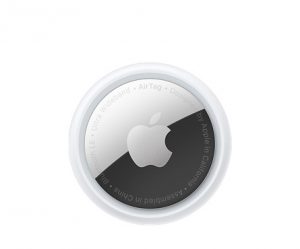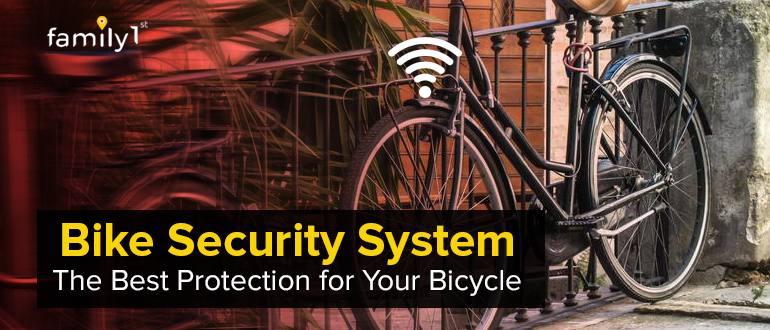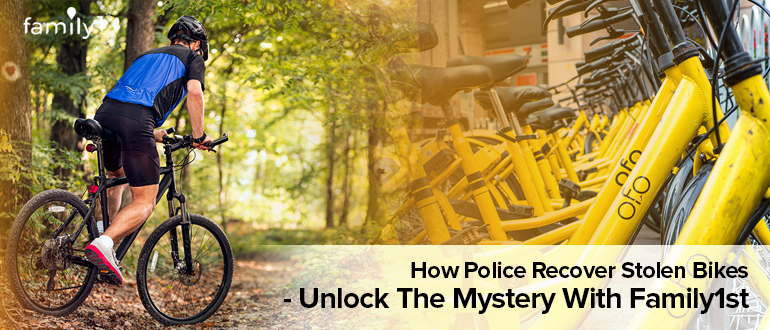In the US, a bicycle gets stolen every 30 seconds, or nearly two million bikes annually, costing approximately $350 million. Their ease of theft, high dispersibility, and lax tracking measures make them a sought-after target for bike thieves. So how can you protect and keep track of it?
Bicycle trackers, like AirTags, help locate stolen or lost bicycles. Initially designed to help users find misplaced items, Apple AirTags for bicycles are increasingly used as location trackers in the biking community. But can it replace GPS trackers?
Keep reading as we explore the benefits of Apple AirTags bicycle trackers, their potential, and if they are a match against established GPS trackers.
Table of Contents
Understanding Apple AirTags as GPS Bike Trackers
Apple AirTag is a small, coin-shaped device designed to help users locate their belongings using the Find My app. These tiny devices are equipped with Bluetooth technology and can be connected to your iPhone to provide precise location information.
While primarily intended for tracking items like keys, wallets, and bags, they have also gained popularity within the biking community as a GPS bicycle tracker. Wondering why? Here are some key features and benefits driving the growth of AirTags:
- A compact and lightweight design.
- A long-lasting battery life that helps you locate your device for months after initial attachment.
- Compatible with a wide range of Apple devices.
- The Precision Finding feature provides real-time distance and directional guidance using the built-in sensors of your iPhone.
- It guides you to your prized possession with visual and haptic feedback, ensuring a more accurate and efficient retrieval process.
- The Find My app stores the location history, allowing you to review past routes, identify frequented areas, and gain insights into your cycling habits.
- With customized notifications and alerts, you can set up your AirTag to notify you if your bicycle is moved or enters and leaves a specified area.
Exploring the Potential of AirTags as a GPS Bike Tracker
There are multiple reasons why bikers are using AirTags as GPS trackers.
Their technical prowess is crucial since they use Bluetooth technology to connect with your iPhone, ensuring accurate and up-to-date location data. Their cost is another factor since the cost of one AirTag is $29 only, while you can buy a pack of four for $99 to save more.
Does this mean that AirTags is the ultimate choice for bicycle location tracking? Not quite. So let’s find out the pros and cons of these devices.
| Pros | Cons |
| Using the Find My app, you can quickly locate your Apple AirTag, and by extension, your bicycle. | The device runs on Bluetooth connectivity which holds a limited range and can restrict the tracking capability in various scenarios. |
| The Precision Finding feature allows you to detect the exact location and direction of the AirTag from your current location by combining inputs from the camera, Bluetooth, ARKit, accelerometer, and gyroscope. Your iPhone will begin vibrating when you are two feet away to let you know you are getting close. | AirTags rely on the presence of Apple devices in the vicinity for optimal performance, which might limit their effectiveness in less populated areas. |
| Changing batteries is painless. You just need to twist the AirTag open when the charge runs out, swap out the batteries, turn it closed, and you are ready to go for another year. | The device is also not 100% water resistant, diminishing its effectiveness as a Bicycle Tracker. |
| You can even use AirTags if you forget where you parked your bicycle. You can enable the Lost Mode to save your phone number and email address. If anyone else finds the lost item, they can use a supported device to go to the website where the Lost Mode message will be displayed. | You must be aware of some legal and ethical issues regarding respecting local privacy and tracking laws and regulations. Ensure you adhere to legal boundaries and ethical guidelines while utilizing AirTags as a GPS bicycle tracker. Always obtain consent if sharing location information with third parties. |
To utilize AirTags as a bike tracker, follow this step-by-step instruction on how to enable them:
Step 1: Ensure your AirTag is ready to be paired

To kickstart your installation process, ensure you have the latest version of iOS installed on your iPhone. Next, activate your AirTag by removing the plastic tab to enable the pairing mode.
Step 2: Install the Find My app
Now, install the Find My app on your iPhone. Then tap the “Items” tab and select “Add New Item”. Finally, select the “AirTag” option and follow the on-screen instructions to pair it with your iPhone. Your iPhone will automatically recognize the AirTag, and you can follow the on-screen instructions to complete the setup.
You can name your AirTag, choose a unique icon for easy identification, and set up related notifications and alerts.
Step 3: Secure your bike with the AirTag
Attaching the AirTag in a conspicuous spot like the basket or beneath the seat is essential. Ensuring that the AirTag stays in place makes locating the tags more straightforward and accurate.
Step 4: Track your bike with an AirTag
Once the setup is complete, you can easily track your bicycle using the Find My app. Open the app and select your bike’s AirTag, and the map will show the last known location. Use the various tracking features and functionalities to track your bicycle continuously and possibly retrieve it if necessary.
Best practices and tips for optimizing AirTags for bike tracking:
Now that you know how to pair up the AirTag to your Apple device try optimizing your overall experience through some simple tips.
- Regularly inspect your bicycle and AirTag setup to ensure everything functions as intended. Verify that the AirTag’s Bluetooth connection is stable and that the bike’s mounting accessory is secure. Address any issues promptly to maintain optimal tracking performance.
- Feel free to check on it in extreme weather conditions since they can damage the tag as it is not entirely weather resistant.
- Use the combination of an AirTag and a robust bicycle lock for maximum security. Secure your bicycle using a U-lock and attach the AirTag out of plain sight, like beneath the seat, to minimize the theft risk and increase the chances of successful recovery.
Apple AirTags vs. Portable GPS Tracking Devices for Bikes – A Comparison
With so many interactive and intuitive features, AirTags offers a convenient and cost-effective solution for tracking. But are they a match for dedicated portable Global positioning system tracking devices? Let’s find out.
Size and Form Factor
AirTags are compact and lightweight, almost discreet whilst attached to your bike. A portable GPS tracker comes in various sizes and shapes according to your specific needs.
Tracking Technology
AirTags are dependent on Bluetooth connectivity and the Find My network for tracking. In comparison, a GPS tracker depends on satellites, resulting in more accurate and reliable results.
Tracking Range
Bluetooth range limitations affect AirTags, whereas portable GPS tracking devices typically provide a broader monitoring range.
Battery Life
Battery life in an AirTag may survive for more than a month, while portable GPS tracking devices may have different variants in battery life per the user’s needs.
Tracking Accuracy
GPS tracking gadgets tend to provide higher accuracy in tracking than AirTags, specifically in regions with limited Bluetooth connectivity.
Features and Functionality
Portable GPS trackers often have advanced features, including geofencing, real-time monitoring, and tamper alerts. These features are not available in AirTags.
Cost Evaluation
Portable GPS trackers are more affordable in the long run than AirTags, making them a budget-friendly option.
Tips to Keep Your Bike Safe
While using AirTags as a GPS tracker can make a difference in your bike’s safety, its drawbacks might leave you wanting more. If that’s the case, you can invest in Family1st’s GPS trackers to take advantage of real-time tracking, ease of use, geofencing, dedicated alerts, and data privacy at a price that doesn’t burn a hole in your pocket.
![]()
Still, it is crucial to undertake the additional measures listed below to discourage thieves:
- Invest in a sturdy lock for your bicycle to prevent any attempts of robbery.
- Store your bicycle in a secure location when not in use.
- Consider installing extra motorcycle protection gadgets like movement sensors or alarms.
- Avoid leaving your motorcycle unattended in public locations for extended periods.
Frequently Asked Questions
Is a Bike GPS tracker worth it?
Yes, a bike GPS tracker can be worth it for many individuals. It provides added security by allowing you to track the location of your bike in real time, increasing the chances of recovering it if it’s stolen. Additionally, some GPS trackers offer features like geofencing and alerts, enhancing bike safety. However, the worthiness of a bike GPS tracker depends on individual needs, the value of the bike, and the prevalence of bike theft in the area.
How to use a bike GPS tracker?
To use a bike GPS tracker, follow these general steps:
- Choose and purchase a suitable bike GPS tracker that meets your requirements.
- Install the tracker on your bike according to the manufacturer’s instructions, usually by attaching it securely to the frame or other safer locations.
- Activate the tracker by turning it on or following the provided activation process.
- Connect the tracker to a compatible mobile app or web platform using the provided instructions.
- Set up any necessary settings, such as geofencing or notifications, based on your preferences.
- Ensure the tracker has a clear view of the sky to acquire GPS signals for accurate tracking.
- GPS tracker begins recording and transmitting your bike’s location data as soon as you start it.
- Monitor the tracker’s data on the mobile app or web platform to track your bike’s location in real-time or review its previous routes.
- If your bike is lost or stolen, report the incident to the authorities and provide them with the tracking data to aid the recovery efforts.
Which is the best bike GPS tracker in 2023?
Family1st Portable Tracker is an excellent choice for tracking bikes due to its versatile features and reliable performance. Its compact and lightweight design allows easy attachment to bike frames or other discreet locations. With advanced GPS technology, this device provides accurate and real-time location tracking of your bike, ensuring peace of mind. The tracker offers additional functionalities like geofencing, allowing you to set boundaries and receive notifications if your bicycle goes beyond them. Its long battery life and durable construction make it ideal for tracking your priced possession – whether for daily commutes or adventurous rides.
Conclusion
Apple AirTags may not offer the range of features as a portable GPS device but serve as a decent alternative. AirTags may provide numerous benefits, but their limitations which include a variety of restrictions and reliance on the software can be a game changer for multiple users.
That said, it is crucial to consider the benefit you can obtain from utilizing them or dedicated GPS trackers. The Apple AirTag might be the best option if you seek a tracking gadget to locate your bike within close range.
But a GPS tracker, like Family1st, is the best option if you need a device with real-time tracking and monitoring features without worrying about the battery life or device range.










Next
Previous